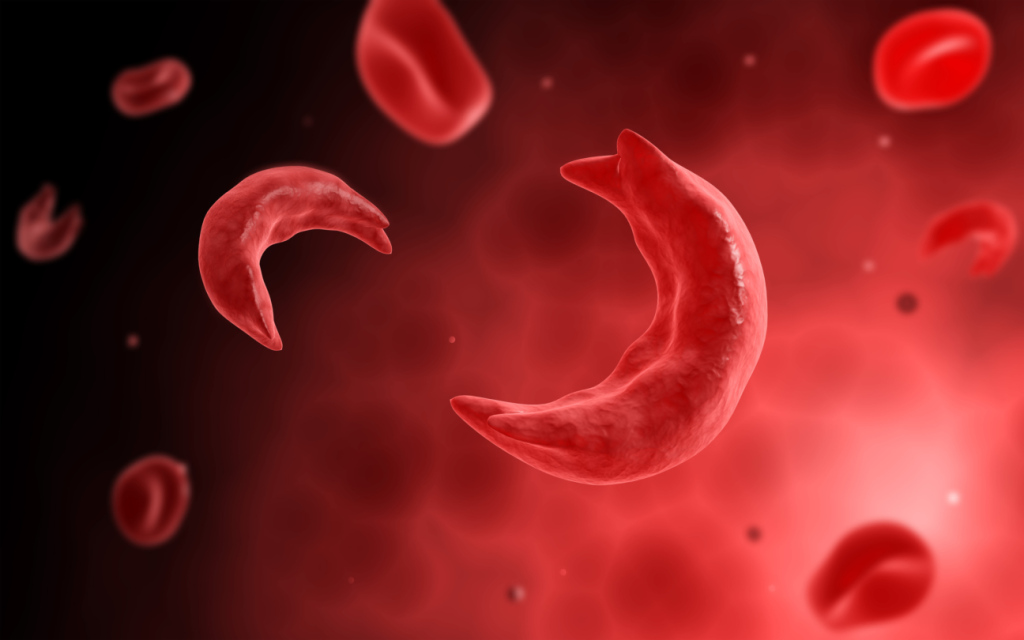
Sickle cell disease is a genetic disorder caused by mutations in the beta globin gene that leads to faulty hemoglobin protein, called hemoglobin S. Hemoglobin S changes flexible red blood cells into rigid, sickle-shaped cells. These sickle cells can block blood flow, and result in pain and organ damage Jun 30, · Sickle cell disease (SCD) is a group of inherited red blood cell disorders. If you have SCD, there is a problem with your hemoglobin. Hemoglobin is a protein in red blood cells that carries oxygen throughout the body. With SCD, the hemoglobin forms into stiff rods within the red blood cells. This changes the shape of the red blood cells 44 rows · Sickle cell anemia is a disease in which the body produces abnormally shaped red blood
What is Sickle Cell Disease? | CDC
SCD is a group of inherited red blood cell disorders. Healthy red blood cells are round, and they move through small blood vessels to carry oxygen to all parts of the body. The sickle cells die early, which causes a constant shortage of red blood cells. Also, when they travel through small blood vessels, they get stuck and clog the blood flow.
This can cause pain and other serious problems such infection, sickle cell anemia, acute chest syndrome and stroke. This is commonly called sickle cell anemia and is usually the most severe form of the disease. Hemoglobin is a protein that allows red blood cells to carry oxygen to all parts of the body. This is usually a milder form of SCD. Did you know SCD affects people from many parts of the world? pdf icon. Those with HbS beta 0-thalassemia usually have a severe form of SCD.
Sickle cell anemia severity of these rarer types of SCD varies. This is called sickle cell trait SCT. People with SCT usually do not have any of the signs of the disease and live a normal life, but they can pass the trait sickle cell anemia to their children, sickle cell anemia. Additionally, there are a few, uncommon health problems that may potentially be related to sickle cell trait.
SCD is a genetic condition that is present at birth. It is inherited when a child receives two sickle cell genes—one from each parent. SCD is diagnosed with a simple blood test.
It most often is found at birth during routine newborn screening tests at the hospital. In addition, SCD can be diagnosed before birth. Because children with SCD are at an increased risk of infection and other health problems, early diagnosis and treatment are important. View and print » pdf icon. People with SCD start to have signs of the disease during the first year of life, sickle cell anemia, usually around 5 months of age, sickle cell anemia.
Symptoms and complications of SCD are different sickle cell anemia each person and can range from mild to severe. There is no single best treatment for all people with SCD. Treatment options are different for each person depending on the symptoms.
Learn about complications and treatments ». Bone marrow is a soft, fatty tissue inside the center of the bones where blood cells are made. A bone marrow or stem cell transplant is a procedure that takes healthy cells that form blood from one person—the donor—and puts them into someone whose bone marrow is not working properly.
Bone marrow or stem cell transplants are very risky, and can have serious side effects, sickle cell anemia, including death, sickle cell anemia. For the transplant to work, the bone marrow must be a close match.
Usually, the best donor is a brother or sister, sickle cell anemia. Bone marrow or stem cell transplants are used only in cases of severe SCD for children who have minimal organ damage from the disease. Skip directly sickle cell anemia site content Skip directly to page options Skip directly to A-Z link. Sickle Cell Disease SCD. Section Navigation. Facebook Twitter LinkedIn Syndicate. What is Sickle Cell Disease?
Español Spanish. Minus Related Pages. Infographic: 5 Facts You Should Know About Sickle Cell Disease. SCD Fact Sheet. Page last reviewed: December 14, Content source: National Center on Birth Defects and Developmental DisabilitiesCenters for Disease Control and Prevention. home Sickle cell anemia Cell Disease Home.
Join the Public Health Webinar Series on Blood Disorders View past webinars. Links with this icon indicate that you are leaving the CDC website.
The Centers for Disease Control and Prevention CDC cannot attest to the accuracy of a non-federal website. Linking to a non-federal website does not constitute an endorsement by CDC or any of its employees of the sponsors or the information and products presented on the website.
You will be subject to the destination website's privacy policy when you follow the link. Sickle cell anemia is not responsible for Section compliance accessibility on other federal or private website.
For more information on CDC's web notification policies, see Website Disclaimers. Cancel Continue.
Sickle Cell Trait- Exertional Sickling in Athletes
, time: 2:21Sickle Cell Disease | Sickle Cell Anemia | MedlinePlus

Jun 30, · Sickle cell disease (SCD) is a group of inherited red blood cell disorders. If you have SCD, there is a problem with your hemoglobin. Hemoglobin is a protein in red blood cells that carries oxygen throughout the body. With SCD, the hemoglobin forms into stiff rods within the red blood cells. This changes the shape of the red blood cells 44 rows · Sickle cell anemia is a disease in which the body produces abnormally shaped red blood Sickle cell disease is a genetic disorder caused by mutations in the beta globin gene that leads to faulty hemoglobin protein, called hemoglobin S. Hemoglobin S changes flexible red blood cells into rigid, sickle-shaped cells. These sickle cells can block blood flow, and result in pain and organ damage
No comments:
Post a Comment